Notre Dame put together a complete effort to kill Syracuse’s dreams, jumping out to an early lead and holding it thanks to contributions from the defense, rushing attack, and special teams. The offensive line and rushing attack allowed Notre Dame to dominate the efficiency battle, but without explosive plays the Orange threatened to pull off the comeback. Thankfully for Marcus Freeman the defense came up with massive turnovers and special teams wins led to an incredible field position advantage (+18 yards per drive!) that allowed ND to separate.
There was no garbage time in this game – the only plays excluded were end of half plays and kneeldowns.
Stats from a few excellent sources – College Football Data, Game On Paper, and often referencing SP+ and FEI numbers. If you get lost, check out this handy advanced stats glossary here or reach out in the comments.
Defensive disruption, trending
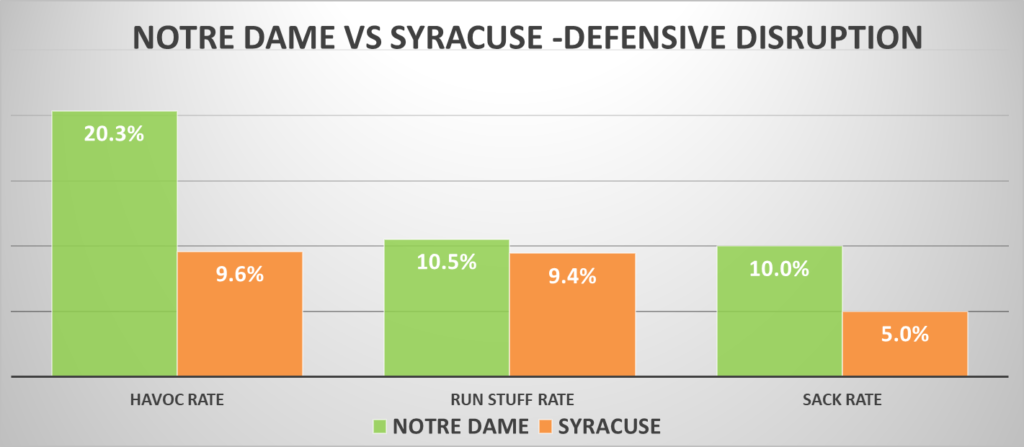
In the last two weeks the Irish have finally seen bad turnover bounces and luck start to trend back in their direction, but Al Golden’s defense is also doing the right things to create opportunities. Notre Dame’s havoc rate was around 20% for the second straight week, with the pass rush once again taking advantage of a juicy matchup (the Orange OL and QB Garrett Shrader had struggled with sacks all year). It was an incredible start after an offseason of hype about Brandon Joseph’s nose for the football to see the transfer safety grab a pick-six and immediately suck the energy out of the Carrier Dome* crowd. The Liufau interception also came at a critical moment with the Irish lead dwindling, and the Cross deflection was somehow the first pass break-up by an Irish defensive lineman this season.
The defense had some bumps in the road, but generally controlled the game and held the Orange to their lowest available yards gained output of the year (30.1% – Clemson allowed 33.4% of available yards gained). It was a major boost that Shrader appeared banged up and left the game at halftime, but Del Rio-Wilson was dangerous in relief and Notre Dame never allowed Sean Tucker to build up momentum on the ground.
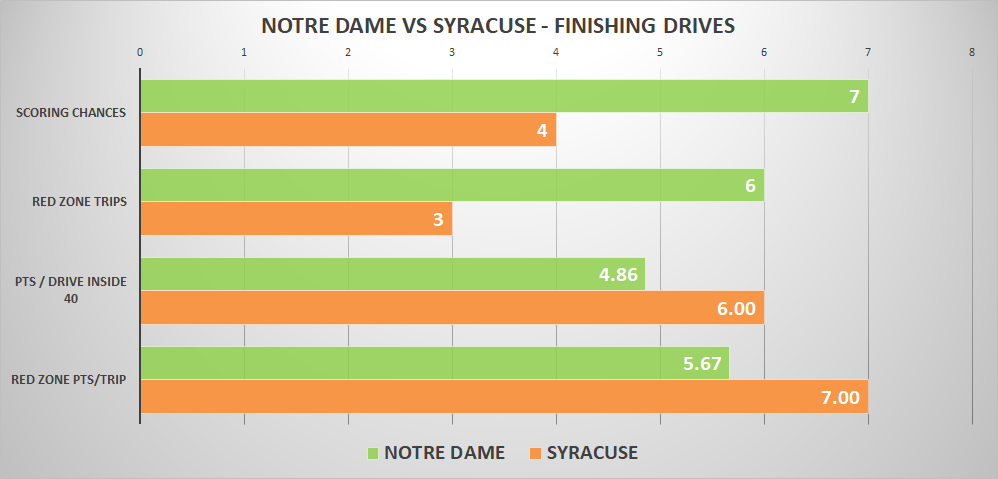
The one area that still has to improve is red zone / scoring opportunity defense. It’s a little bizarre that the defense performs well forcing three-and-outs and in overall stop rate but then struggles so badly to prevent touchdowns in the red zone. After allowing Syracuse to go 3-for-3 on Saturday the Irish has fallen behind Rutgers and is now dead last in FBS in Red Zone TD% allowed (85%)! There’s inevitably some bad luck involved here, but Al Golden has to take a long hard look at how to better defend in these situations.
How far can the run game propel the offense?
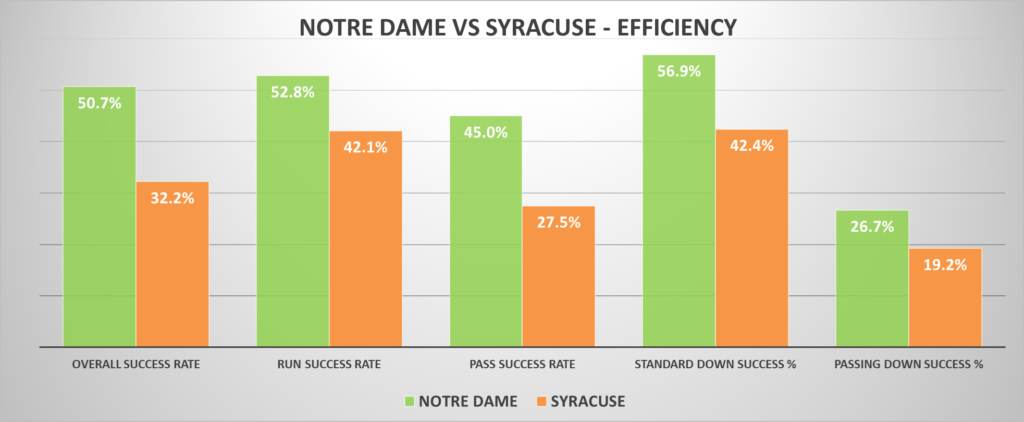
Notre Dame’s rushing attack was the best unit on the field against the Orange, and Tommy Rees didn’t try to overcomplicate things. The Irish rushed on 81% of early downs, and were consistently able to move the chains and stay on schedule with an average first down gain of 5.4 yards. Those numbers are even more impressive when you factor in that seven 1st down pass attempts averaged just 4.4 yards per play.
I wrote last week about the fear that fumbling issues could limit Audric Estime’s snaps when he’s been the most explosive and productive back this year, and it was terrific to see his bounce-back against Syracuse. The sophomore was successful on 13 of 20 carries for 6.2 yards per rush, outshining his classmate Logan Diggs (9/20 successful, 4.3 yards/rush).
The rushing game is the backbone of the offense, at this point by default with the state of the passing attack. But the important question isn’t if the Irish are better rushing or passing, but if the run game is good enough to drive strong offense virtually on its own. This is an offense that lately with Pyne struggling has been even more run-heavy than the 2017 or 2020 offenses – is it close to as productive on the ground?
ND’s O is 60.1% run on the season. Last 3 games they’re 64%. For perspective, they were 56% in ’20 with Tremble as a wrecking ball, 59.5% in ’17 with Wimbush, and 56.4% in ’12 with a “riding the bus” Golson. That and more notes after Syracuse https://t.co/xS7QB4pwuO
— Jamie Uyeyama (@jamieuyeyama) October 31, 2022
The numbers reflect that it’s not even close. The last four years the Notre Dame yards per carry average has floated between 5.1 – 5.8 yards. Over the last three games (Stanford, UNLV, Syracuse), against a collection of poor run defenses, the rushing yards per game has only been between 4.6 – 4.9. The rushing game has been efficient, but without much explosiveness at all, with only 2 rushes of 30+ yards, T98 in FBS.
The key has been consistently gaining yardage and avoiding defensive disruption – Notre Dame is now up to 8th nationally in stuff rate allowed. Against Syracuse the average 3rd down distance to gain was only 4.5 yards. It’s been about keeping things moving, and the degree of difficulty is high without much downfield threat, but more creativity and a counterpunch will be required against Clemson and other quality defenses.
The no explosive plays plan works (in this matchup)
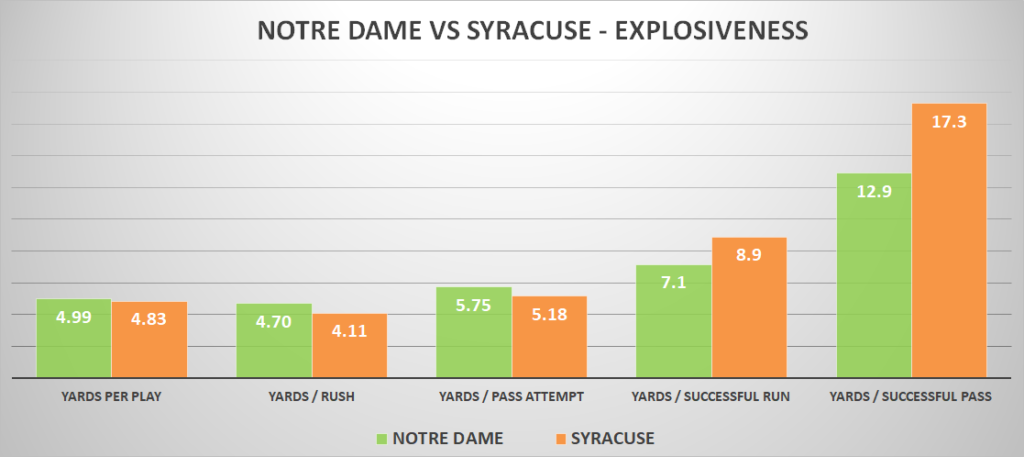
Only 4 of Notre Dame’s 73 plays (excluding kneel-downs) went for more than 15 yards, as the Irish struggled once again to break off long gains. The struggles to manufacture explosive plays along with Pyne’s struggles on passing downs is usually a lethal combination, but in this game the defense, special teams, and running game were good enough that it didn’t matter. The Irish defense did a terrific job limiting explosiveness as well, allowing a long gain of 30 yards and only 5 explosive plays on 59 defended.
Fighting in a phone booth with no explosive plays allowed works when you’re the more physically dominant team, and Notre Dame’s strength in the trenches has showed up over the last few weeks. But it creates such a slim margin for error for the defense when the offense can’t create chunk plays. The Irish dominated the efficiency battle but barely out-gained Syracuse in yards per play, with slight edges both rushing and passing the ball.
Notre Dame can win without explosive plays, and they’re probably due for some positive regression – a missed tackle here, a blown coverage there, a deep receiver open and this time the ball is on target. But the current formula is relying on sustained longer drives, which have been easier to cash in for points the past two weeks as the Irish benefit from outstanding field position (five drives started at the Irish 40 or better).
How can the Irish best set up Pyne?
No one needs advanced stats to know that Drew Pyne and the passing game are really struggling. The difference in the last three games is pretty stark – BYU and UNC are truly terrible defenses, but I don’t think Stanford, UNLV, and Syracuse represent such a step up in difficulty that explains the splits below (thanks to Brendan R for the quick breakdown):
- Cal/UNC/BYU: 63/85 (74.1%), 701 yards (8.2 ypa), 8 TD, 1 INT
- Stan/UNLV/Syr: 36/74 (48.6%), 472 yards (6.4 ypa), 4 TD, 2 INT
We know there are things that can help – avoiding passing downs where Pyne has struggled mightily, leveraging more play-action. But there has to be some balance involved – if the opponent knows your tendencies to go run-heavy on early downs, you need to threaten and keep them honest.
One relatively easy solution might be returning to the running back involvement in the passing game. Over the past three games, running backs have been targeted just 6 times (8.1% of pass attempts). In Pyne’s first three starts, he was throwing it to a running back three times as often, with 20 targets to backs on 85 attempts (23.5%). Passes to backs sometimes aren’t efficient thanks to check-downs or incompletions when the QB is under pressure, but in those first three games 45% of those pass plays were successful with an average gain of 9.35 yards. Bring back more two back sets, and help Pyne find some easy gains that will also loosen things up for the running game so opponents cant simply load up the box.
On to Clemson
Syracuse was a massive win to give the Irish some momentum heading into this gigantic home matchup instead of fretting about finishing 6-6. On paper, this is a very realistic upset opportunity – the Tigers are strong but not outstanding on either side of the ball so far despite a lot of NFL talent. There’s the potential for bad QB from Clemson, including turnovers, and quarterback controversy. The Irish DL could have some edges in the trenches against a Tiger OL that has often been the weakest point on some of Dabo Swinney’s elite teams.
The defense has also underperformed given the talent on hand, especially in the front seven. There’s been injuries and absences, but with Brent Venables gone it has to be concerning to see different attacks like Wake Forest, Florida State, and Syracuse having success at times. Can Notre Dame replicate any of what those teams did well? It will be challenge without a mobile QB like the Noles and Orange featured, and without the talented QB and WR combinations the Demon Deacons used to exploit some holes in Clemson’s deep coverage. I don’t think it’s hyperbole to call this the biggest game of Tommy Rees’s OC career.
I’d like to be hopeful, but a one-dimensional Irish attack has virtually no chance of succeeding in this matchup. While Clemson is vulnerable thanks to mediocre and inconsistent QB play, DJ Uiagalelei throws a nice deep ball and the rushing attack figures to be one of the best Notre Dame has seen since Ohio State. If the defense can keep things close, does the offensive gameplan try to manufacture enough to pull out the win? Or like in the Ohio State game, will that trigger the offense to ensure they aren’t the unit that makes a critical mistake with a shaky QB?
Ideally this is a team starting to put it all together in some key places, with a coordinator that has some tricks still up his sleeve. But at a minimum a solid Pyne effort paired with another terrific defense and special teams performance will be required to pull off back to back wins over Clemson in South Bend.

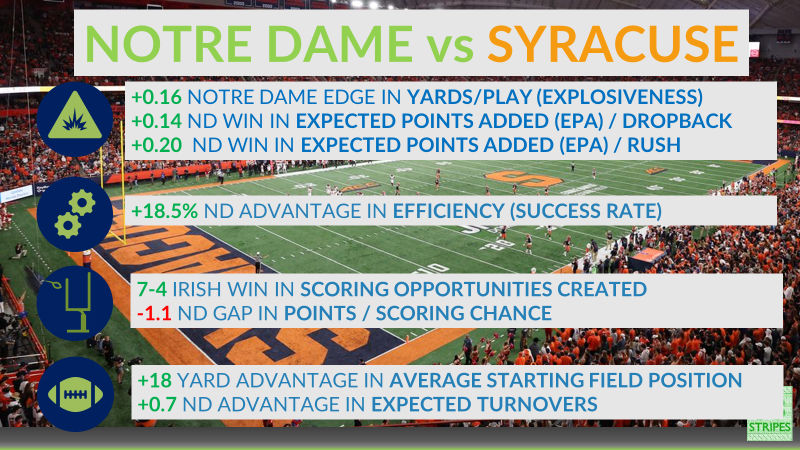



For RZ defense, it seems like we run tons of delayed blitzes. On Cuse’s slant for on of the all time easiest TDs, Liufau waits about a second before blitzing.
It looks like it was a read, and when 81 stayed in to block, he just ran into the line. Could have been more helpful dropping into coverage or just not running right into the back of his own teammate.
Yep, I was so frustrated on that play. No good QB is the holding the ball for a long time in the red zone. Attack immediately or drop into coverage. Hesitation and delays just don’t work down there.
Advanced stats don’t include drops, correct? This felt like the first game where our opponent dropped way more passes than the Irish did. Our DBs caught some major breaks.
I don’t see any world in which we beat Clemson without some newfound explosiveness. If Tommy can find a way to generate it, he will be back in my good graces. (Or I guess Foskey could block a couple more punts)
No drops in the play by play, need premium PFF numbers or another source that’s charting (same with play action, blitz, by coverage stats, etc)
I remember hearing some goofy stat about penn state that their longest rushing td last year was the 11-15 yards or something. If my memory is correct nd longest rushing td this year is like 12 yards. Will they bust a long run for a td? Will ND exceed the jack coan 21 yard rushing td from last year? Man that’s depressing to put it that way.
Somme what related I would junk all tyree handoffs. They can try and get him the ball via pass but watching him fall at every contact is killer
It’s pretty depressing! Yes, 12 yards in longest rushing TD.
Overall ND is 121st in 40+ yard plays with 3, tied for 116th in 50+ yard plays (1) which funny enough was the very first play from scrimmage for the offense against Ohio State. That doesn’t necessarily mean your offense sucks – Utah and Wake are in similar spots with lack of long plays and doing well – but man would it make life easier when you have shaky QB play and have to try to grind out long drives.